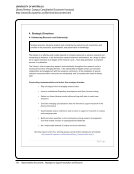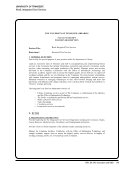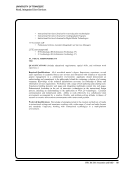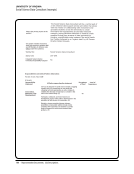16 · Survey Results: Executive Summary
as a component in their strategic mission, the survey
also explored R&D as a programmatic area used to
support innovation, research, and new programs and
services. Thirty-one respondents (69%) indicated that
their library invests resources in R&D projects 14 (31%)
said no. Of those 31 who invest in R&D, only nine (29%)
indicated that a specific unit has R&D responsibilities.
Other comments indicted that R&D responsibilities
are diffused throughout the library. The examples of
R&D activities reported are very wide ranging. Many
of the examples pertain to technology, services, user
studies, or space. One interesting reference was made
to two “R&D think tanks” that have activities ranging
from theoretical exploration to prototyping to devel-
opment. Eight respondents provided information on
the number of staff in the R&D units. They range from
one to 10 full-time staff a few also have part-time or
student staff. Most of the units report (6 or 75%) report
to someone other than the university librarian.
The 22 libraries that do not have a separate R&D
unit often stated that innovation and R&D is expect-
ed throughout the organization. “Every manager is
encouraged to include innovative opportunities in
annual goals of staff,” wrote one respondent. Several
wrote that they may originate in any unit or from a
cross-functional team. The comment below seems to
best characterize the responses to this question:
“There is no formal staff or structure. We recog-
nize the importance of it and want the organiza-
tion to be flexible enough to allow for different
units to engage in R&D activities as necessary.
Most of our efforts are on a small scale, and our
resources in general are limited so this approach
suits us well.”
Research &Development: Funding
The survey next explored sources of funding that li-
braries obtain and allocate to R&D activities. All but
one of the 30 respondents said that funding for R&D
comes from the library’s operating budget. Twelve
(40%) reported that the library received funding from
the parent institution, and twelve noted that funding
for library R&D came from external sources. Again,
only five libraries reported that they had a separate
R&D budget line. One allocates $5,000 a year to R&D.
The other four have budgets of $100,000 to $475,000
devoted to R&D activities.
The most common process for securing funding
from a parent institution for library R&D is a competi-
tive process at the institutional level, followed closely
Figure 2. Descriptions of Library R&D Activities Word Cloud
as a component in their strategic mission, the survey
also explored R&D as a programmatic area used to
support innovation, research, and new programs and
services. Thirty-one respondents (69%) indicated that
their library invests resources in R&D projects 14 (31%)
said no. Of those 31 who invest in R&D, only nine (29%)
indicated that a specific unit has R&D responsibilities.
Other comments indicted that R&D responsibilities
are diffused throughout the library. The examples of
R&D activities reported are very wide ranging. Many
of the examples pertain to technology, services, user
studies, or space. One interesting reference was made
to two “R&D think tanks” that have activities ranging
from theoretical exploration to prototyping to devel-
opment. Eight respondents provided information on
the number of staff in the R&D units. They range from
one to 10 full-time staff a few also have part-time or
student staff. Most of the units report (6 or 75%) report
to someone other than the university librarian.
The 22 libraries that do not have a separate R&D
unit often stated that innovation and R&D is expect-
ed throughout the organization. “Every manager is
encouraged to include innovative opportunities in
annual goals of staff,” wrote one respondent. Several
wrote that they may originate in any unit or from a
cross-functional team. The comment below seems to
best characterize the responses to this question:
“There is no formal staff or structure. We recog-
nize the importance of it and want the organiza-
tion to be flexible enough to allow for different
units to engage in R&D activities as necessary.
Most of our efforts are on a small scale, and our
resources in general are limited so this approach
suits us well.”
Research &Development: Funding
The survey next explored sources of funding that li-
braries obtain and allocate to R&D activities. All but
one of the 30 respondents said that funding for R&D
comes from the library’s operating budget. Twelve
(40%) reported that the library received funding from
the parent institution, and twelve noted that funding
for library R&D came from external sources. Again,
only five libraries reported that they had a separate
R&D budget line. One allocates $5,000 a year to R&D.
The other four have budgets of $100,000 to $475,000
devoted to R&D activities.
The most common process for securing funding
from a parent institution for library R&D is a competi-
tive process at the institutional level, followed closely
Figure 2. Descriptions of Library R&D Activities Word Cloud
































































































































































































